Panama Canal - Panama Canal
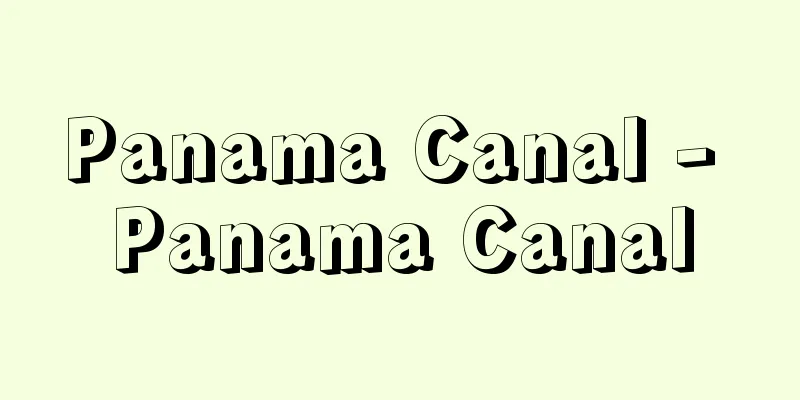
|
A canal that crosses the Isthmus of Panama in Central America to connect the Caribbean Sea and the Pacific Ocean. It is a waterway with a total length of about 82 km, stretching from the port of Cristobal on the Caribbean side to the port of Balboa on the Pacific side, and is extremely important in terms of transportation and military strategy. It is a lock canal, consisting of the three-stage locks at Gatun, the single-stage locks at Pedro Miguel, and the two-stage locks at Miraflores. Ships travel 11 km from Cristobal through the canal to the artificial lake of Gatun Lake, where they are raised to the same altitude as Gatun Lake, 26 meters. Ships travel 40 km across Gatun Lake to the Culebra Canal, which was excavated in the hilly region that is the backbone of the Isthmus of Panama. Ships are then lowered to 17 meters above sea level at the Pedro Miguel Locks, and further to sea level at the Miraflores Locks before navigating the 13-kilometer canal to Balboa on the Pacific coast. The canal takes about eight hours to navigate, and only 40 ships are allowed to pass through per day. Large tankers and aircraft carriers weighing more than 65,000 tons are not permitted to pass through. As ships became larger after World War II, the number of ships passing through the canal stagnated from 15,000 per year in the late 1960s, and in fiscal year 1998 (October 1997 to September 1998), the number of ships passing through the canal was 13,025. Toll revenues were $545.7 million (fiscal year 1998), of which $106.9 million was paid to the Panamanian government. [Yuzo Kamo] historyThroughout the Spanish colonial period, the Isthmus of Panama was an important route for transporting silver produced in the Viceroyalty of Peru to the home country, and was called the "Royal Road." The Spaniards had considered building a canal across the isthmus as early as the 16th century, but centuries passed without any realization. The importance of the isthmus was once again recognized strongly in the mid-19th century, when the Gold Rush occurred in California, USA, and the development of a route that would allow easy travel from the east coast to the west coast of the United States was necessary. In response, a private American company began construction of a railroad across the Isthmus of Panama in 1850, and it was completed in 1855. At a time when the transcontinental railroads of the United States had not yet been completed, this railroad played an important role as a route connecting the Atlantic and Pacific oceans. In 1860 (Man'en 1), the first Shogunate mission to the United States, carrying the ratification document of the Treaty of Amity and Commerce between the United States and Japan, used this railroad on its way to Washington via Panama. The first company to undertake the construction of a canal across the Isthmus of Panama was a private French company, which obtained the rights to build a canal from the Colombian government and began construction in 1881 under the direction of Ferdinand de Lesseps, who had built the Suez Canal. However, due to the construction being more difficult than expected, a lack of funds, and the ravages of malaria and yellow fever, the company went bankrupt in 1889 when two-fifths of the canal had been dug, and construction of the canal was halted. After a private French company failed to build the canal, the US government took over and completed it in the early 20th century. At that time, the US had acquired the Philippines and Guam in the war with Spain in 1898, and had also annexed Hawaii, and had begun to expand into Asia and the Pacific. To make such expansion easier, there was a growing need for a route to cross the Central American isthmus from the east coast of the US to the Pacific Ocean. During the war with Spain, it took 67 days for the warship Oregon to circumnavigate from San Francisco to Florida via Cape Horn at the southern tip of South America, which made American politicians and citizens keenly aware of the need for a canal. The distance traveled by the Oregon, 19,000 kilometers, could have been shortened by about one-third if there had been a canal in the Central American isthmus. Immediately after the war, the US government began negotiations to revise the Clayton-Bulwer Treaty, which prohibited the US and British governments from exclusively building canals in the Central American isthmus. In the Second Hay-Poncefort Treaty of 1901, the United States obtained from the United Kingdom the right to build a canal on its own and to fortify the canal zone. At that time, Nicaragua and Panama were considered as potential locations for the construction of a canal on the Central American isthmus. The United States decided to take the Panama route, and after negotiating with the Colombian government, concluded a treaty in January 1903 that allowed the US government to build a canal on the Isthmus of Panama and control it. However, the threatening attitude shown by the US government of Theodore Roosevelt over the ratification of the treaty provoked a backlash from the Colombian Congress, which ultimately refused to ratify the treaty. Meanwhile, the residents of the Panamanian region, who were increasingly inclined to secede from Colombia, were deeply disappointed by the Colombian Congress' refusal to ratify the treaty and began plotting independence. On November 3 of the same year, they decided to secede from Colombia, hoping for support from the US government. This independence was successful, with the help of intimidation from American warships, and the US government recognized the Republic of Panama on November 6th. The United States immediately concluded a canal treaty with the Panamanian ambassador, Frenchman Philippe Bunau-Varilla (1859-1940). This treaty was much more favorable to the United States than the previous treaty with Colombia, and gave the United States the right to build and operate the Panama Canal, and to "possess as if it were a sovereign of the territory" the Panama Canal Zone, a 16-kilometer wide zone stretching from the Caribbean coast to the Pacific coast, and to "perpetually use, occupy, and control" it, in exchange for which it would pay the Panamanian government $10 million upfront and $250,000 annually from nine years later. The ambiguous wording in this treaty later became the cause of disputes between the two countries over which side had sovereignty over the canal zone, but Panama was forced into a semi-colonial state for more than half a century under the interpretation that sovereignty belonged to the United States. The US government began construction of the canal in 1904, and it was opened on August 15, 1914, on the eve of World War I. The opening of the canal made it much easier for America to expand into Asia, the Pacific, and the Pacific coast of South America. The Panama Canal and the Caribbean region at its entrance became so strategically important to America that they were called "areas of vital importance" to America. Meanwhile, Panama was placed in a semi-colony under the above treaty, and the huge tolls earned from the canal went entirely to the US, meaning that the country's greatest resource, a key transportation hub, could not be utilized, and its development stagnated. The annual payment to the Panamanian government was subsequently increased to $430,000 in 1933 and $1,930,000 in 1955, but this amount was only 1.3% of the $143 million in canal tolls (1975). Panama's dissatisfaction with these economic disadvantages and discrimination against Panamanians in the Canal Zone grew, and in 1964, it erupted into riots that began with a dispute over the raising of the Panamanian flag in the Canal Zone. Shocked by this incident, the US government began negotiations for a new canal treaty. However, pressure from the Panamanian side to return sovereignty over the Canal Zone intensified under the government led by nationalist General Torrijos, who was born in a coup in October 1968. The Canal Zone is important from a military perspective for the United States, as it is home to a huge U.S. military base and the Southern Command, which oversees the U.S. military's operations in Latin America, and from Panama's perspective, it posed a risk of being drawn into a war. However, as Latin American countries supported Panama's demands, the United States eventually gave in and concluded a new Canal Treaty with the Panamanian government in September 1977, which was ratified the following April. The new Canal Treaty stipulated that sovereignty over the Canal Zone rests with Panama, and stipulated that ownership and operation of the canal would be handed over to Panama at the end of 1999, that annual payments to Panama would be significantly increased, and that Panamanians would be involved in the operation of the Canal Zone. In return, the military bases would remain in place for the time being (the last base was returned in November 1999). At noon on December 31, 1999, the Panama Canal and surrounding areas were handed over from the United States to Panama. Thus, the problems with the old canal treaty were temporarily resolved. However, the current canal is old, has locks that make it take a long time for ships to pass through, and is narrow, so ships over 65,000 tons cannot pass through. This led to the idea of building a new canal, and since 1982, Panama, the United States, and Japan have been discussing the possibility of building a second Panama Canal. In 2006, the Panamanian government planned to expand the Panama Canal, and in October of the same year, a national referendum supported the expansion plan. Construction is underway with the aim of completing the canal in 2014, the 100th anniversary of its opening. After the expansion work is completed, the maximum allowable ship size will be increased to 366 meters in length, 49 meters in width, and 15 meters in draft. The current locks will remain in use even after the expansion work is completed, and the canal's capacity is expected to increase by about 80%. [Yuzo Kamo and Satoshi Suzuki] History from the perspective of construction technologyThe Panama Canal is a 82 km long lock canal that was excavated through the Isthmus of Panama to connect the Caribbean Sea and the Pacific Ocean. Construction began in 1881 as a horizontal canal by Lesseps, who had completed the Suez Canal, but it ended in failure. Later, the canal was converted to a lock system and Eiffel, the builder of the Eiffel Tower, was invited to work on it. However, the bankruptcy of the Panama Canal Company in February 1889 put an end to the French construction. The rights to the construction of the Panama Canal were then transferred to the United States. When construction resumed in 1904, William Crawford Gorgas (1854-1920) implemented thorough quarantine measures against yellow fever and malaria, which were endemic to the Isthmus of Panama. Colonel George Washington Goethals (1858-1928), who became the chief engineer for the canal's construction in 1907, used state-of-the-art steam engines and dredgers, and the construction was completed in 1914 under military discipline by the United States Army Corps of Engineers. The canal is a typical lock canal with double concrete walls and aqueducts. It is 33-109 meters wide and about 14 meters deep at its shallowest point. The Chagres River was dammed at Gatun Dam to create an artificial lake, Gatun Lake, with a water surface elevation of 27 meters above sea level, and a 14-meter deep gaillard cut was excavated in the Gold Hill region. The volume of earthworks, including incidental works, for the construction of the canal was approximately 185 million cubic meters, and approximately 3.8 million cubic meters of concrete was used for the locks and dams. Madden Dam was then built on Madden Lake, and the Panama Canal Zone Comprehensive Development Plan was also implemented. [Hideo Igarashi] "Study on the impact of the expansion of the Panama Canal on the global shipping and shipbuilding industry" compiled by the Japan Small and Medium Shipbuilding Industry Association (2009, funded by the Nippon Foundation)" ▽ "History of the Panama Canal" by Tsuneo Kawai (Kyouikusha Rekishi Shinsho) ▽ "Panama Canal - People whose shadows were reflected in the water" by Hirotsugu Yamaguchi (Chuko Shinsho) [References] | | | | | | | |The canal connects the Caribbean port of Cristobal (Colon) and the Pacific port of Balboa (Panama City). The photo shows the Miraflores Locks. Panama City, Panama ©Shogakukan "> Panama Canal ©Shogakukan "> Cross-section and location of the Panama Canal Source: Shogakukan Encyclopedia Nipponica About Encyclopedia Nipponica Information | Legend |
|
中央アメリカのパナマ地峡を横断してカリブ海と太平洋を結ぶ運河。カリブ海側のクリストバル港から太平洋側のバルボア港に至る全長約82キロメートルの水路で、交通および軍事戦略上きわめて重要な運河である。閘門(こうもん)式運河で、ガトゥンの三段式閘門、ペドロ・ミゲルの一段式閘門、ミラフロレスの二段式閘門からなる。クリストバルから運河を11キロメートル航行して人造湖のガトゥン湖に至り、ガトゥン閘門でガトゥン湖と同じ標高26メートルまで船舶は持ち上げられる。ガトゥン湖を40キロメートル航行し、パナマ地峡の背骨である丘陵地帯を掘削したクレブラ堀割に至る。ついでペドロ・ミゲル閘門で船舶は標高17メートルまで下げられ、さらにミラフロレス閘門で海水面まで下げられたのち、約13キロメートルの運河を航行して太平洋岸のバルボアに至る。運河航行に約8時間を要し、1日40隻が限度である。6万5000トン以上の大型タンカーや空母は通行できない。第二次世界大戦後の船舶の大型化によって、通行船舶数は1960年代末の年間1万5000隻から伸び悩み、1998会計年度(1997年10月~1998年9月)の通行船舶数は1万3025隻。通行収入は5億4570万ドル(1998会計年度)で、そのうち1億0690万ドルがパナマ政府に支払われた。 [加茂雄三] 歴史スペインの植民地時代を通じて、パナマ地峡は、ペルー副王領で産出した銀を本国に運ぶ重要なルートで「王道」とよばれていた。スペイン人は早くも16世紀に、この地峡に運河を建設することを考えていたが、実行に移されぬまま数世紀が過ぎ、この地峡の重要性がふたたび強く認識されたのは、19世紀のなかばにアメリカのカリフォルニアでゴールド・ラッシュが起こって、アメリカの東海岸から西海岸にまで容易に行くことができる交通路の開拓が必要になったときであった。それにこたえてアメリカの民間会社が1850年にパナマ地峡を横断する鉄道の建設に着手し1855年に完成した。アメリカの大陸横断鉄道がまだ完成していなかった当時、この鉄道は大西洋と太平洋を結ぶ交通路として重要な役割を果たした。1860年(万延1)には日米修好通商条約の批准書を携えた幕府の最初の訪米使節団が、パナマ経由でワシントンに行く途中この鉄道を利用している。パナマ地峡の運河建設に最初に着手したのはフランスの民間会社で、コロンビア政府から運河建設のための権利を獲得し、スエズ運河を建設したフェルディナンド・ド・レセップスの指揮のもとで1881年に運河建設を開始した。しかし、想像以上の難工事、資金の枯渇、マラリアや黄熱病の猛威により、1889年に5分の2を掘ったところでこの会社は破産し運河の建設は中断した。 フランスの民間会社が運河建設に失敗したあと、20世紀の初頭にそれを引き継いで完成させたのがアメリカ政府である。当時アメリカは、1898年のスペインとの戦争でフィリピンとグアムを獲得し、またハワイを併合するなど、アジアや太平洋地域へ進出を開始していた。このような進出をさらに容易にするために、アメリカ東部海岸から中央アメリカ地峡を横断して太平洋に出るためのルートの必要性が強まった。スペインとの戦争の際に、軍艦オレゴン号をサンフランシスコから南アメリカ大陸南端のホーン岬経由でフロリダまで周航させるのに67日も費やしたことは、アメリカの政治家や国民に運河建設の必要性を痛感させた。オレゴン号が航行した1万9000キロメートルの距離は、中央アメリカ地峡に運河があれば約3分の1に短縮できたからである。戦後ただちにアメリカ政府は、米英両国政府が中央アメリカ地峡で運河を独占的に建設することを禁じたクレートン‐ブルワー条約を改定する交渉に乗り出した。1901年の第二次ヘイ‐ポンスフォート条約で、アメリカが単独で運河を建設し、運河地帯を要塞(ようさい)化できる権利をイギリスに認めさせた。当時中央アメリカ地峡で運河建設の候補地とみなされていたのはニカラグアとパナマであった。アメリカはパナマ・ルートをとることを決定し、コロンビア政府と交渉して、1903年1月、アメリカ政府がパナマ地峡に運河を建設し、それを支配することを認めた条約を締結した。しかしその批准をめぐってアメリカのセオドール・ルーズベルト政府が示した脅迫的な姿勢がコロンビア議会の反発を招き、結局議会は条約の批准を拒否した。一方、コロンビアからの分離傾向を強めていたパナマ地方の住民たちは、コロンビア議会が条約の批准を拒否したことに深く失望し独立の陰謀を進めた。同年11月3日、彼らはアメリカ政府からの支援を期待しつつコロンビアからの分離独立に踏み切った。この独立は、アメリカから派遣された軍艦による威圧などの助けを借りて成功し、アメリカ政府は11月6日にパナマ共和国を承認した。 アメリカはただちに、パナマの特命全権大使であるフランス人ビュノーPhilippe Bunau-Varilla(1859―1940)との間で運河に関する条約を締結した。この条約は先にコロンビアとの間で結んだ条約よりもはるかにアメリカにとって有利なもので、アメリカ政府はパナマ運河を建設し運営する権利と、カリブ海岸から太平洋岸に至る幅16キロメートルのパナマ運河地帯を「あたかも領土の主権者のごとく所有し」、それを「永久に使用、占有、支配する」権利を獲得し、その代償としてパナマ政府に即金で1000万ドル、9年後から毎年25万ドルを支払うことを定めた。この条約のなかのあいまいな表現が、その後運河地帯の主権がどちらかにあるかをめぐって両国間でなされた紛争の原因となったが、主権はアメリカ側にあるという解釈のもとでパナマ側はその後半世紀以上にわたって半植民地的な状態を強いられた。アメリカ政府は1904年に運河の建設に着工し、第一次世界大戦前夜の1914年8月15日に開通した。運河の開通により、アメリカの、アジア、太平洋や南アメリカの太平洋岸地域への進出は飛躍的に容易になった。パナマ運河とその入口に位置するカリブ海地域はアメリカにとって「死活にかかわる地域」とよばれるほどその戦略上の重要性が増した。一方、パナマは前記条約のもとで半植民地状態に置かれ、運河から得られる莫大(ばくだい)な通行料はすべてアメリカが獲得したため、交通の要衝というこの国の最大の資源を生かすことができず、発展は停滞した。 パナマ政府に対する年間の支払い額は、その後、1933年には43万ドル、1955年には193万ドルへと増額されたが、この額は、運河通行料が1億4300万ドル(1975)であったのに比べて、そのわずか1.3%というものであった。このようなパナマ側にとっての経済的不利益や、運河地帯でのパナマ人に対する差別などに対してパナマ側の不満は増大し、1964年に運河地帯でのパナマ国旗の掲揚をめぐって起こった争いに端を発した暴動となって爆発した。この事件で衝撃を受けたアメリカ政府は新しい運河条約のための交渉に着手した。しかし、運河地帯の主権返還を要求するパナマ側からの圧力は、1968年10月にクーデターで生まれた、民族主義者トリホス将軍が指導する政権のもとで一段と高まった。運河地帯にはアメリカ軍の巨大な軍事基地や、ラテンアメリカでのアメリカ軍の作戦行動を統轄する南方軍司令部が置かれるなど、アメリカにとって軍事的な面からも重要であり、パナマ側からみればそれらによって戦争に巻き込まれる危険性をもっているという問題があった。しかしパナマ側の要求をラテンアメリカ諸国も支持したため、結局アメリカは譲歩して、1977年9月、パナマ政府との間に新運河条約を締結し、翌年4月に批准された。新運河条約は、運河地帯の主権がパナマ側にあることを明確にするとともに、1999年末に運河の所有、および運営をパナマ側に引き渡すこと、パナマへの年間支払い額を大幅に増額すること、運河地帯の運営にパナマ人を参加させることなどを定めており、そのかわり軍事基地は当分の間存続することとなった(1999年11月、最後の基地を返還)。1999年12月31日正午、パナマ運河および周辺地帯はアメリカからパナマに引き渡された。このように旧運河条約がもっていた問題についてはいちおうの決着がつけられた。しかし、現在の運河が老朽化していることや、閘門式のため船舶の通行に時間がかかること、幅が狭いため6万5000トン以上の船は通行できないなどの欠点があるため、新運河建設の構想がおこり、1982年以来、パナマ、アメリカ、日本の間で第二パナマ運河建設の可能性について検討がなされた。2006年にパナマ政府はパナマ運河の拡張を計画し、同年10月には国民投票において拡張計画の支持を得た。開通100周年にあたる2014年竣工を目ざし、工事が進められている。拡張工事終了後には、最大許容船型は全長366メートル、幅49メートル、喫水15メートルへ拡大される。また、現在の閘門は拡張工事終了後も供用され、運河の容量は約80%増加するとされている。 [加茂雄三・鈴木聡士] 工事技術からみた歴史パナマ運河は、パナマ地峡部を開削してカリブ海と太平洋を結ぶ全長約82キロメートルの閘門式運河である。1881年、スエズ運河を完成させたレセップスにより水平式運河として着工されたが失敗に終わった。 その後、閘門式運河に切り換えられ、エッフェル塔の建設者エッフェルが招かれた。しかし、1889年2月のパナマ運河会社の倒産によりフランス人による工事は幕を閉じた。そしてパナマ運河建設の権利はアメリカ合衆国に移った。1904年に工事が再開されるや、ゴーガスWilliam Crawford Gorgas(1854― 1920) によりパナマ地峡地帯の風土病である黄熱病やマラリアなどに対して徹底的な防疫処置が行われた。1907年に運河建設の主任技師になったゲーサルスGeorge Washington Goethals(1858―1928)大佐は、新鋭の蒸気機関や浚渫(しゅんせつ)船を用い、さらにアメリカ合衆国工兵隊により軍事的規律の下で工事を行い1914年に完成した。 この運河は二重のコンクリート壁と導水管からなる代表的な閘門式運河である。幅33~109メートル、水深は、もっとも浅い地点で約14メートルである。チャグレス川をガトゥン・ダムでせき止め、水面標高27メートルの人造湖ガトゥン湖をつくり、ゴールド・ヒル丘陵地帯に深さ約14メートルのゲーリャード・カット(堀割)が掘削された。 付帯工事を含め、運河建設の土工量は約1億8500万立方メートルで、閘門やダムに使用されたコンクリートは約380万立方メートルであった。その後、マッデン湖にマッデン・ダムが建設されパナマ運河地帯の総合開発計画も進められた。 [五十嵐日出夫] 『日本中小型造船工業会編『パナマ運河拡張が世界の海運・造船産業に与える影響に関する調査』(2009・日本財団助成)』▽『河合恒生著『パナマ運河史』(教育社歴史新書)』▽『山口廣次著『パナマ運河――その水に影を映した人びと』(中公新書)』 [参照項目] | | | | | | | |カリブ海側のクリストバル港(コロン)と太平洋側のバルボア港(パナマ市)をつなぐ運河。写真は、ミラフロレス閘門。パナマ パナマ市©Shogakukan"> パナマ運河 ©Shogakukan"> パナマ運河の断面図と位置 出典 小学館 日本大百科全書(ニッポニカ)日本大百科全書(ニッポニカ)について 情報 | 凡例 |
>>: Panama City (English spelling)
Recommend
Yale College
…One of the Ivy League schools. The third oldest ...
Nathan the Wise
A five-act dramatic poem written by German Enligh...
Master Clock Theory - Oyadokeisetsu
…In German, it is called Zeitgeber, and the rhyth...
Kawachi Takaoka
?-? A government official and poet in the Nara pe...
Plastocyanin
A copper protein found in many plants, from lower ...
Ballotage
…There are two types of majoritarian systems: tho...
Burges, W.
…His name is originally pronounced Con-der. In hi...
Reformation (English spelling)
This refers to the 16th century church reform tha...
Nine Chapters of Arithmetic
This is one of the 10 surviving ancient Chinese m...
Screw flower - Screw flower
A perennial plant of the orchid family (APG class...
Calmette, G. (English spelling) Calmette G
…He was an effective politician who opposed the p...
Small book - Kohon
〘 noun 〙 (also "kobon") 1. A small book....
Pinus luchuensis (English spelling) Pinusluchuensis
… Matsu [Toshio Hamatani]. … From [Pine] … [Makot...
Xuzhou Operation
From April 7 to May 19, 1938, the Japanese army pi...
Acalypha godseffiana (English spelling)
… [Takabayashi Masatoshi]. … *Some of the termino...
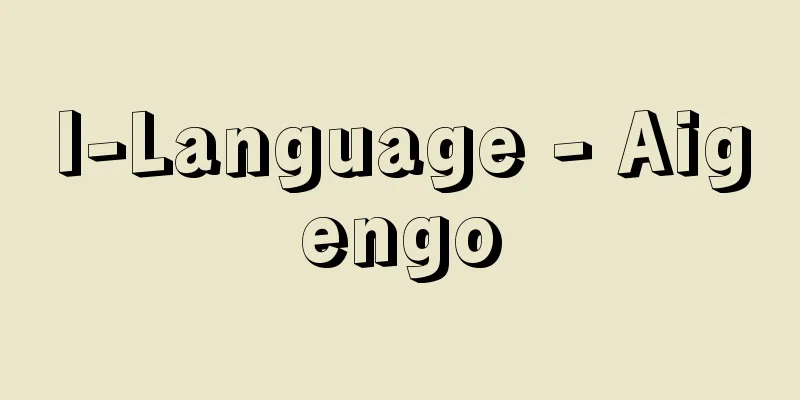

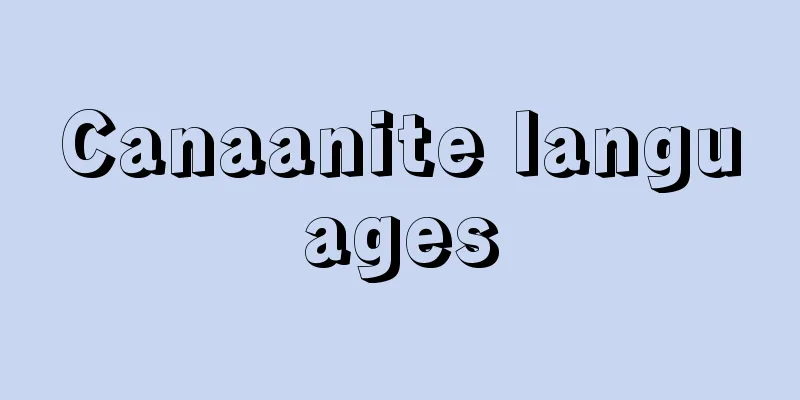



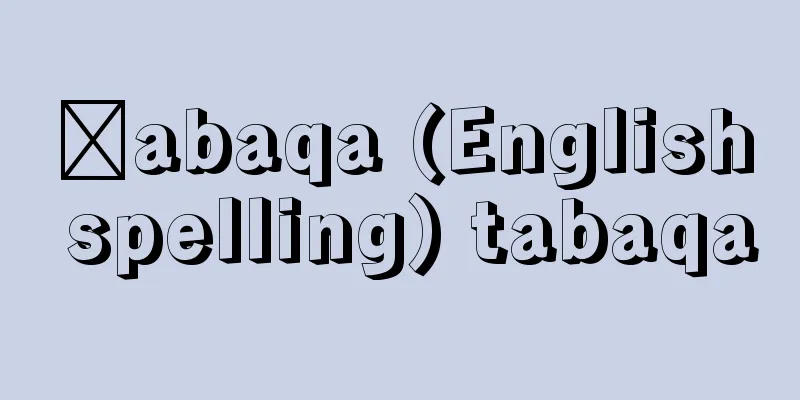

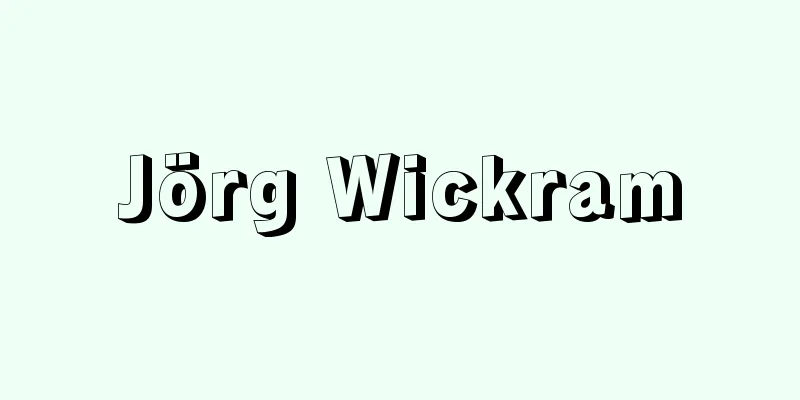
![Ichikawa [City] - Ichikawa](/upload/images/67caec426e002.webp)